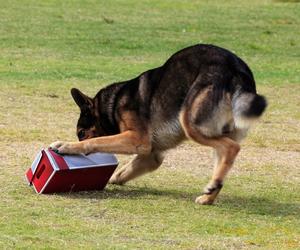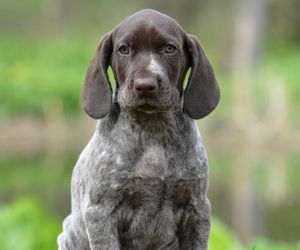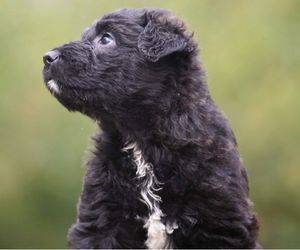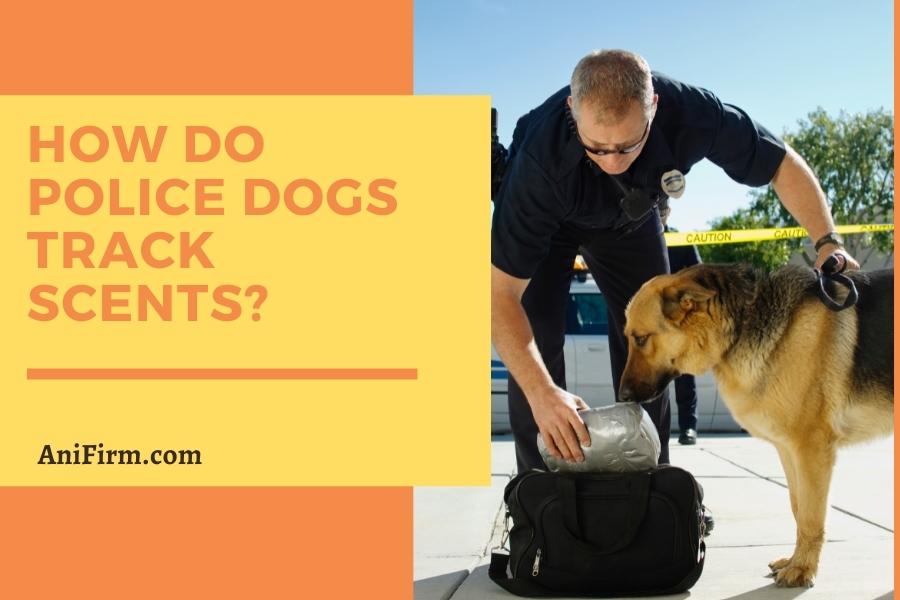When it comes to tracking scents, a police dog is extremely good at it. It can detect odors from miles away. But how does it do that?
Police dogs have immense nose power or the ability to smell things. With 300 million olfactory receptors, the dog can smell every molecule in a scent source, even the tiniest molecules. A human nose has only 6 million olfactory receptors. So a dog’s sense of smell is 50 times more powerful than ours.

Police dogs‘ brain is also designed to track odors. Their brains are more prominent and have stronger connections than humans. It lets them process information much faster—the part of the brain where scents are sent is 40 times more significant in dogs than in people. So, a police dog can easily detect the smell of a criminal on a trail.
The vomeronasal organ is also part of a dog’s sense of smell. This organ is mostly used for social interactions.

What Smells Do Police Dogs Track?
As we mentioned before, dogs have a tremendous sense of smell. They can smell a molecule from a long way away. But what scents do they track?
Police dogs track many smells because they need to follow many different scents. For example, they have to track food, drugs, arson, and explosives. Here is the list of the smells police dogs track.
1. Suspicious Sents

Dogs can sense fishy smells from a long way away, enabling them to track criminals. They help the police by providing the exact location or piece of evidence.
2. Human Body

Dogs are alerted when someone is bleeding or sick, so police dogs are often used for cadaver searches. They can also smell the missing person’s stuff to track them down.
3. Drugs

Dogs are also trained to track illicit substances. They assist the police in locating drug labs and smugglers. Police use dogs in airports, train stations, bus stations, and other public places to detect drugs hidden in people.
4. Explosives

Dogs have been successfully trained to track and detect explosives. They help the police in bomb squad searches. They can detect explosives such as TNT, RDX, and PETN at low concentrations.
Three Factors that Affect the Ability of A Police Dog to Track a Scent
1. Breed Of Your Dog
Different breeds have different skills for scent detection. Some breeds are better than others. For example, German Shepherds have excellent noses for tracking scents and locating objects. Genetics affect the tracking ability. If your dog is bred for hunting, he can track scents better than a dog bred to protect people.
Jacobson’s organ has an organ known as the Second Nose in the upper area of the dog’s mouth. This Second nose senses odors from obstacles and hides them from other smells. As a result, this organ allows the dog to smell better and track scents faster and better than other dogs.
2. Environmental & Surrounding Conditions Of Scent
The ecological and surrounding conditions have taken the utmost importance in tracking odors. Here are four environmental factors that affect the tracking ability of a Police Dog.
- Temperature of Air
- Wind conditions
- Humidity
- Snow and Rain
3. How Much Training The Dog Has Got For Sniffing Or Scent Tracking
The scent tracking ability also depends on how much training the dog has had. The amount of training a dog gets affects his tracking and detection skills. It also affects his motivation to track scents. It is scientifically shown that the more a dog is trained, the better the traces of odors become.
Many techniques can help train a police dog to increase its odor-detection abilities. Sometimes, it can be its favorite toy dipped in drugs or a towel containing a drug in it.
Like drug detection dogs, explosives detection dogs are trained to detect explosives. They can distinguish between various high explosives and can identify even trace amounts of explosive compounds.
So How Long Can Scent Survive?
There are many views on how long a dog can use scent trails. According to many volunteers, a dog can sniff the Scent of any object no more than 15 days old. The law enforcement officers also mentioned the same experience.
How Long Can A Police Dog Track A Scent?
Tracking a suspect or a criminal is often the primary mission of a police dog. A dog’s keen sense of smell can come in handy when monitoring people, especially those trying to hide evidence that might be incriminating. For example, detectives can train dogs to sniff out human remains, especially when the remains are fresh and in pristine condition. When police dogs track a scent trail, they have left behind a trace of material evidence, such as blood, human tissue, hair, or cigarette butts.
As I mentioned before, the genres and the weather play a huge role in scent tracking. So, the tracking ability of the dog is affected. Some dogs are more talented when tracking scents, others less so. Some dogs sense the “ground trackers”, and others are “air trackers”.
The ground tracker’s dogs track scents from the ground; they dig their paws and nose into the ground and detect a scent trail. These dogs can follow the scents which are more than 8 hours in undisturbing climatic conditions.
Air trackers track the scents from the air; they walk or run and sense a scent trail. They also detect smells from a quarter of a mile in the air.
German shepherd dogs are used to tack disturbance scents. These dogs can smell the crushed grass, broken undergrowth, disturbing tarmac, and track. That’s why shepherds are best suited for tracking the scents.
The spaniel-type dogs you see are trained for specific smells. For example, the Bloodhound dog is used for tracking blood, the Foxhound dog is used to track lions and foxes, the Bloodhound dog is used to track blood, and the Scenthound dog is used for monitoring certain odors. These dogs also have other unique talents, including the ability to find underwater hunting and locating lost people or animals using scent detection. They are also good at guarding people or properties. In general, these dogs are brilliant and tend to have a very gentle temperament.
Popular Police Sniffer Dogs
Here is the list of the popular police dog breeds that are successful as K9 drug detectors.

Belgian Malinois

German Shorthaired Pointer

Beagle

Briard

Giant Schnauzer

Bloodhound

Boxers

German Shepherd

Doberman Pinscher

Cane Corso

Airedale Terrier

Labrador Retriever

American Pit Bull Terrier

Bouvier des Flandres

Dutch Shepherd
What You Need For Scent Work Training
Find the necessary supplies to teach your dog Scent Work at home. Almost everything you need is available online or in your home.
- Birch essential oil
- Cotton swabs, cut in half
- Tweezers
- A small glass jar with a lid
- A “scent vessel” to hold the cotton swab. (Start with a clean, empty mint tin with holes drilled in the lid.)
- Disposable gloves
- High-value treats
- A lidded, plastic container with holes drilled in the lid
After Arranging The Equipment, Follow These Steps:
1st Step: Clean and Prepare the Odor and Scent Vessel
2nd Step: Teach Your Dog To Recognize Scents
3rd Step: Teach Your Dog to Find the Scent
4th Step: If your dog manages to track out the scent, reward him with his favorite toy or chew.
Begin Training Your Puppy Early
Your puppy nose is one of their most powerful senses, so start nose training early. The scent is as vital to puppies as sight and sound and informs them more about their environment than humans might think. This can be used in games and puppy training, e.g. hide and seek, Find the treats game, etc.
How Do Dogs Track Criminals?
The dog’s olfactory epithelium has several smell receptors. Crime-fighting dogs have a keen sense of smell. Most police dogs can track persons and drugs. They learn to scent the ground for a person’s scent trail and to sense the air for a person’s scent “cone” when nearby.
Labrador Retriever, Cur, Slovensky Kopov, Bloodhound, Lacie, Drahthaar, and German Wire-Haired Dachshund exhibit these features. These dogs can be trained to be great blood-tracking deer dogs.
What did we learn from all this?
A police dog has a fantastic ability to pick up even the smallest scents. Because of their incredible sense of smell is used for many purposes, including detecting drugs, locating missing persons, and finding evidence. However, the ability of a sniffer dog to detect scents differs from place to place. It depends on many factors, including the breed, the smell, and the temperature.
The time of the scent trail depends on where the person was, weather conditions, the clothing worn, etc. The scent trail can last from 2 to 3 days, depending on the weather and how it was worn or touched. Despite all these factors, the dogs can still sniff out the slightest traces of any materials.
I think this article answers all the questions related to dogs tracking a scent! If you think I missed something, please comment!
Frequently Asked Questions about how police dogs track a scent?
The sniffer dog has a fantastic sense of smell because it can identify the odor of the odorant (substance) and the person’s health. The dog’s nose has thousands of olfactory receptors, which allow it to detect odors. It is proven that a sniffer dog can detect any small objects almost 20km away.
Bloodhound dogs have the remarkable ability to pick up scents at distances of over 130 miles. Therefore, a bloodhound can pick up the smell of an animal or human person from miles and miles away. It also can smell any odor that is almost 300 hours old.
Yes, police dogs can smell through aluminum foils! If these dogs have been trained in such situations, they can smell anything. The police use these dogs in locating people or tracking fugitives, but they can also track drugs or explosives.
The human body scent trails last from 2 to 3 days on any object the person touched or wore. If the thing is washed or cleaned, the track mostly fades away. Generally, the scent trail lasts from 2 to 3 days. It depends on the climate and what the person is doing at the time.
If the drug doesn’t seal properly in the lab, the dog can sniff it out. It depends on the dog’s training, the type of drug, and the testing procedure. If the drug is placed in a sealed bag, the dog will not be able to smell it.
The fabrics are the best material to hold the Scent for a long time because it absorbs any odor and stores it in the fabric so the dog can’t smell it.
Some scents do get lost during rain, but not all. For example, the smell of human remains is washed away easily during rain. But the Scent of the perfume or cologne remains for a long time. Blood detection dogs can smell blood after it rains on wooden objects. But in concrete or cement, the Scent gets washed away easily.
